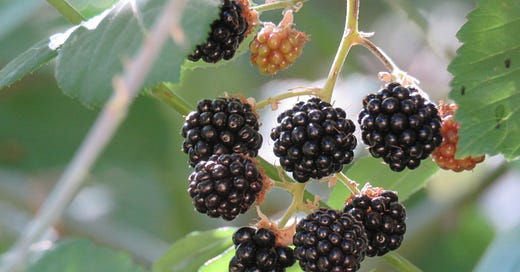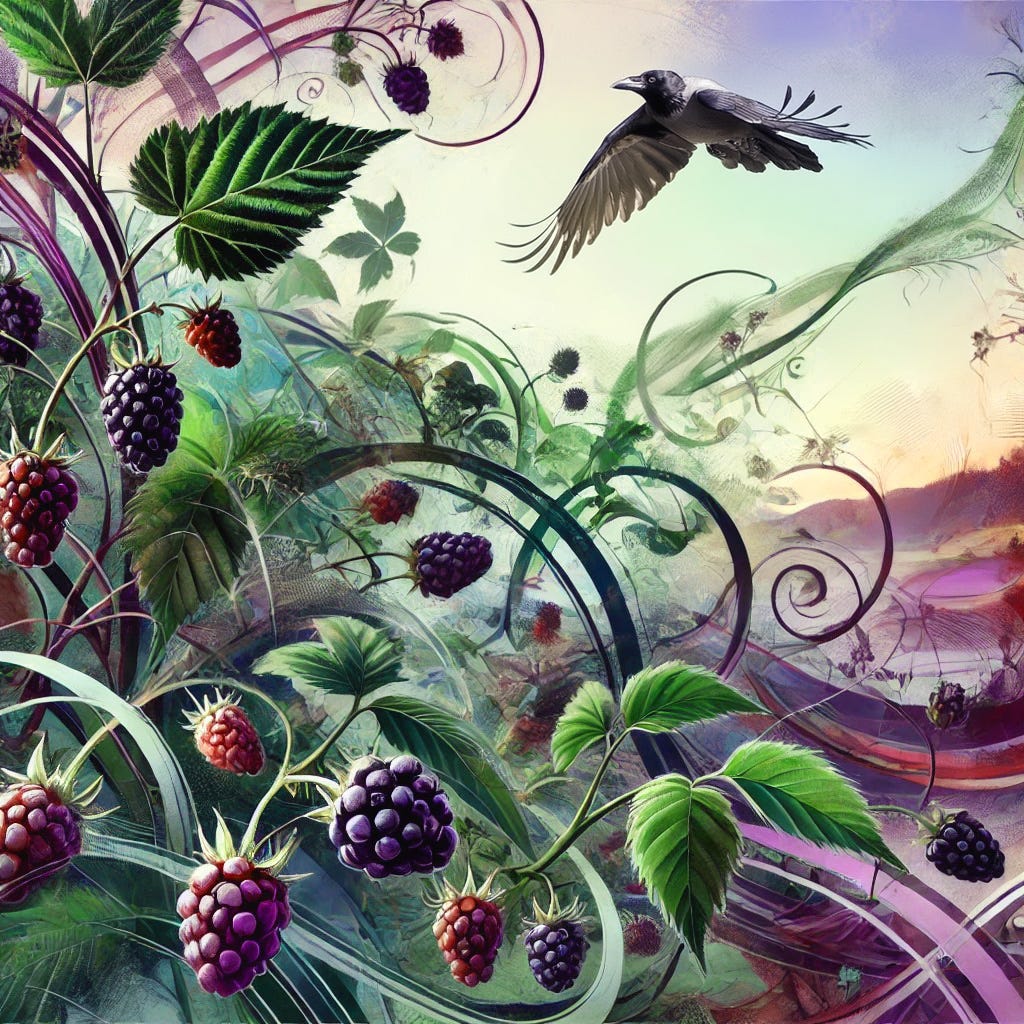Weekender Encore: Nature’s Sweet Treasure — The Blackberries of Napa Valley
By Kathleen Scavone
NAPA VALLEY, Calif. — Blackberry brambles appear as if by magic near streams, and wetlands and roadsides are loaded with the wild edibles, too. Last winter's prolific rains provided for an abundance of berries now, and people aren't the only mammals who consume them. Coyotes, foxes, raccoons, skunks and bears also include berries in their diets.
Birdwatchers can tell you where berry bushes are located and also that many bird species, such as quail, consume them. Birds become berry couriers when they dine, inadvertently planting more berries since their droppings contain their own fertilizer packages.
The purple-black beauties found across the Napa Valley are most often the introduced Himalayan blackberry, Rubus discolor. The California Invasive Plant Council explains that the Himalayan blackberry may be native to Europe, not Asia, and was likely introduced and promoted in North America as a new crop plant in 1885.
The blackberry native to North America is Rubus ursinus. Sometimes called California blackberry, this plant also harbors prickly vines and luscious berries but is not seen as frequently as the Himalayan variety. The native plant's flowers are smaller than those of its cousin, the Himalayan, and the leaves are a bit rounder. Berries of the native plant are similarly tasty, and they, too, are well-loved by many avian and mammalian species. If you’d like to encourage the native berry plant to thrive in your garden, the Napa Valley Chapter of the California Native Plant Society holds native plant sales twice a year, and sometimes they offer native blackberries for sale.
Himalayan blackberry bushes produce long, arching canes and lovely pink or white blooms that bees and other pollinators love to frequent prior to the magic of harvest. Since this thorny plant can quickly take over the landscape due to the prolific seed production, they are not well-loved by farmers. The fast-growing blackberry displaces plants as well as native grasses in pasturelands. Livestock such as cattle and sheep don't like to graze in grounds with these plants because they have been known to entangle the animals’ young in their arching canes.
Late-summer harvest time provides blissful blessings of fresh eats from our home gardens, along with local farmers markets, which sometimes offer blackberries for sale. If you are lucky enough to find a blackberry patch of your own in which to pick, you can gorge like a black bear gearing up for its not-quite-hibernation — the sleep state called torpor. In that case you have hit the lottery. Blackberries are loaded with antioxidants such as anthocyanins and contain healthy amounts of vitamins C, E and K along with calcium and manganese.
Indigenous people of numerous groups have understood the benefits of berries for millennia. In “California Indians and Their Environment,” authors Kent G. Lightfoot and Otis Parrish explain that shoots from young native blackberries were once used to make a boiled tea, which helped alleviate ailments such as dysentery and diarrhea. Archaeologists have found evidence of blackberry residue that indicated past use of the berry in numerous tribal locations. Blackberries were often consumed raw, and in some areas they were dried, ground into a powder and then used to boil into tea.
In “Edible and Useful Plants of California,” Charlotte Bringle Clarke also gives details about Indigenous uses of berries, explaining that pemmican was made using blackberries into which dried meat and fat were mixed. The Cahuillas, a southern California tribe, soaked unripe berries in water to create a tasty, nutritious drink.
Nobel Prize-winning poet Seamus Heaney poignantly writes (and reads on YouTube) about blackberries with poignancy in his poem “Blackberry Picking,” which brings all of the senses into play. When Heaney addresses the appearance of multihued berries as they come into ripeness, the sweet wine taste of a berry, the feel of the sticky juice running down his arms and the prick of the thorns as they try but don't succeed in warning him away from the succulent fruit, we are there with him picking the fruit.
Recipes that include blackberries abound. Some simple ideas include adding a cup of the ripe fruit to any muffin recipe before baking or sprinkling some berries into pancake batter. And who doesn't love blackberry syrup as a topping on pancakes or ice cream? You can cut the sugar in half, and it will still taste great. The piece de resistance has to be blackberry pie, which everyone knows is delicious.
Enjoy some quality time in sunshine and nature, and pick a bucket of blackberry goodness. The jewel-toned fruit is as tasty as it is eye-catching — well worth the inevitable pricks and scratches you might acquire along the way.
If today’s story captured your interest, explore these related articles:
Birdwatching in Napa County Reveals Avian Wonders and Conservation Champions
Weekender Encore: The Napa Valley Writers’ Conference Starts Soon
Weekender Encore: ‘The Real Housewives of Napa Valley’ Revealed
Kathleen Scavone, M.A., retired educator, is a potter, freelance writer and author of “Anderson Marsh State Historic Park: A Walking History, Prehistory, Flora, and Fauna Tour of a California State Park,” "People of the Water" and “Native Americans of Lake County.” She loves hiking, travel, photography and creating her single-panel cartoon, “Rupert.” She can be reached through her website.







All the above!
Glad to learn more about blackberries. Thanks!